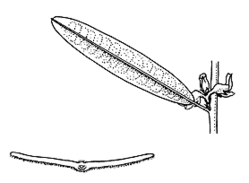Hovea lanceolata Sims APNI* Synonyms: Hovea sp. R sensu Lee & Thompson (1984) APNI*
Hovea sp. B sensu Jacobs & Pickard (1981) APNI*

Description: Shrub up to 3 m tall. Indumentum of branchlets, petiole, stipules, pedicel, abaxial surfaces of bract and bracteoles and external surface of calyx dense, grey to grey-brown, hairs predominantly coiled, less often a majority of hairs straightish and divergent.
Leaves lorate to very narrow-elliptic or lanceolate, 3.5–9 cm long, 7–15 mm wide (juveniles to 10 cm long and to 17 mm wide); more or less flat but often concave-folded when immature, midrib slightly recessed, base rounded to subacute, margins flat, apex rounded to acute, mucro up to 1 mm long; upper surface green and glossy or hoary grey and dull, glabrous except for coiled white hairs along the midrib, less often covered to varying degrees with minute hairs, smooth, venation usually indistinct; lower surface completely obscured by a light to dark tan or grey-tan coiled hairs hairs, midrib hairs dense, brown. Stipules narrow-ovate to lanceolate, 1.0–3.2 mm long, apex often acuminate.
Inflorescences on a short peduncle mostly to 1.5 mm long, commonly 3-flowered, less often 2- or 4-flowered. Flowers with bracts inserted at or up to 0.5 mm distal to base of pedicel, narrow-ovate 1.0–2.5 mm long, overlapping bracteoles or almost so; bracteoles inserted at base of calyx, lanceolate 1.5–3.0 mm long: calyx 5.-7 mm long, indumentum grey or grey-brown, often brown apically; tube 2.5–3.8 mm long; upper lip c. 3–4 mm wide across base, apex of lobes rounded, intervening sinus c. 1 mm deep; lower lip c. 5 mm wide across base, lateral lobes c. 1–2 mm long, lower lobe 1.5–2.5 mm long; standard 8–10 mm long, 9–13 mm wide, claw 2.2 mm long, limb dark mauve, flare green-yellow, 2 mm wide, bordered by a zone of purple; wing 7–7.5 mm long, 3–4 mm wide, usually with a prominent entral lobe towards the apex, claw 2 mm long; keel 5–6 mm long, 2.4–3 mm wide, claw 2 mm long.
Pod obliquely orbicular, 10–15 mm long,10–15 mm deep, sessile, external surface glossy, hardly obscured by an indumentum of scattered, pale hairs, glabrescent, internal surface moderately densely hairy. Seeds ellipsoid, 5 mm long, 3.2 mm wide, brown mottled brown/black or reddish/black, aril oblong, 3.2–3.5 mm long, 1.6–2 mm wide, extending c. 50% of the curved length of seed.
Flowering: Flowers in August and September. Fruit matures in November–December.
Distribution and occurrence: Common in inland parts of north-eastern NSW from the Queensland-NSW border south to Cowra. also in south-eastern Queensland south of Kingaroy. Grows in shaly and skeletal soils and in loams overlying granite and metamorphic rock in forest and woodland.
NSW subdivisions: NT, NWS, CWS, NWP
Other Australian states: Qld
Hovea lanceolata is distinguishable from other forms with a similar indumentum by a combination of large flat leaves, inflorescences in twos or threes, relatively large stipules, a large calyx with a relatively large upper lip and a pod that is sparsely haired externally.
Text by Louisa Murray
Taxon concept: I.R. Thompson (2001) Eastern Australian Hovea (Brongniartieae-Fabaceae). Australian Systematic Botany, Vol 14, pp 61-62.
APNI* Provides a link to the Australian Plant Name Index (hosted by the Australian National Botanic Gardens) for comprehensive bibliographic data
***The AVH map option provides a detailed interactive Australia wide distribution map drawn from collections held by all major Australian herbaria participating in the Australian Virtual Herbarium project.
|


